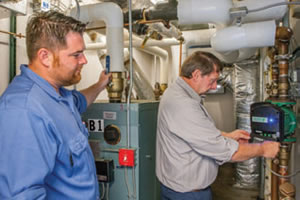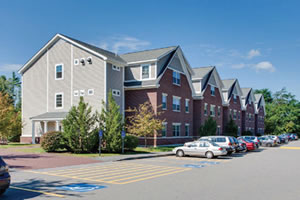Upgrades at SNHU
Between 2000 and 2010, the U.S. saw full-time college enrollment rise by 45 percent. Southern New Hampshire University (SNHU) in Manchester wasn’t an exception. The school added two new residence halls in 2006 to accommodate the influx of new knowledge seekers. Each three-story building houses 130 students.
Although the school built newer residence halls in 2013, the 2006 buildings remain a favorite among students and maintenance personnel alike. But there was one thing university managers wanted to improve. At the time of construction, the technology allowing commercial hydronic circulators to accurately respond to system changes didn’t exist. So, eight years later, it was time for a change. Comfort, system longevity and, most importantly, operating expenses can be dramatically improved with a simple change in the boiler room.

PHOTOS COURTESY OF CHUCK KENDRICK
Quick Upgrade
Each of the 37,000-square-foot buildings is heated by two 725 MBH Smith cast iron boilers connected to commercial fin-tube baseboard in dorm rooms and hydronic coils inside air handlers for common areas. Reverse-return piping was used with two-inch supply lines. Originally, a redundant pair of fixed-speed, in-line pumps was used to distribute heating fluid. Regardless of the call for heat — or lack of it — the “duty” pump ran continuously while the building was in heating mode.
“In 2011, we added an energy management system with outdoor reset, so that the pumps would shut off at 65°F outdoor ambient, even if the building was in heating mode,” says Adam St. Germain, supervisor of SNHU’s plumbing and heating department. “This at least kept the pumps from running if nobody actually shut the heating system down.”
“It also meant the boilers could go into standby mode, as opposed to heating water circulated through the main,” he continues. “There’s less heat loss along the mains when the water isn’t moving.”
The change was a step in the right direction. The pumps still ran at one speed, whether one zone or all 35 were calling. It was most wasteful of energy when the building was at part-load, such as during the shoulder seasons when the sun’s energy on one side was sufficient to passively heat exposed areas, eliminating the call for heat.
Early in 2013, SNHU managers began to consider ways to further improve hydronic efficiency for the 2006 residence halls. Armand Turcotte of The Granite Group, wholesalers of HVAC and plumbing supplies, knew of SNHU’s desire to improve system energy efficiency and suggested that St. Germain take a look at a self-sensing circulator.

PHOTOS COURTESY OF CHUCK KENDRICK
BUILT FOR COMFORT. Constructed in 2006, two residence halls on the Manchester, NH-based campus of Southern New Hampshire University recently underwent an upgrade to improve occupant comfort, system longevity and operating expenses. Data from a retrofit to system pumps in the boiler room indicate that the new pumps have cut power consumption by more than half.
Stepping up Their Game
After learning about an ECM-driven (electronically commutated motor) line of products, St. Germain examined the mechanical systems on campus with special attention to system pumps. He was eager to learn if the two residence halls could finally have a responsive and more efficient pumping system without the need for major renovations or addition of pressure sensors.
St. Germain enlisted the help of Turcotte and Mike Hanson, distributed product sales, NH territory, for rep firm Emerson Swan, to review the original engineering diagrams. After comparing numbers with specifications of the new line of pumps, he decided to replace the four existing pumps with web-enabled, wet rotor, variable speed pumps. While an ECM motor inherently means less energy expended to circulate system fluid, the real advantage to using the selected pumps is the ability to automatically sense and respond to load and pressure changes in the main loop.
The lack of existing pressure sensors throughout the building, or a control system to relay the message, made selecting the self-sensing, or sensorless, technology an easy choice, modulating flow rates to precisely accommodate the variation in demand when a zone valve opens or closes. This self-sensing capability lends itself to retrofit applications where running control wires and installing pressure sensors would be invasive and cost prohibitive.
It also means that controllability is increased because the pressure at the zone valves is consistent. Complaints of over- or under-heated rooms are now a thing of the past, and zone valve maintenance has decreased dramatically.
No Passing Zone
“It was a relatively simple swap-out,” says St. Germain. “It took our staff — with the help of AE Mechanical Inc. — two days to replace all four circulators. It would’ve gone faster if we wouldn’t have added check valves as well.”
Because the original, single-speed pumps were entirely manual in their operation, each one was isolated with a pair of ball valves. When maintenance crews wanted to switch the pumps from duty to standby mode, they would physically walk to the mechanical rooms, kill power to both pumps, and change the position of the ball valves before restoring power.
Because the new pumps can switch from “duty” to “standby” either automatically or by remote web monitoring, the school’s plumbing and heating staff needed a better way to restrict flow through the standby pump.
Without the check valves, water would have simply rushed around the header, instead of moving out into the building. Although it wasn’t their initial function, the ball valves remain in place for service isolation.
“We expected the pumps to be more complicated and harder to install,” explains St. Germain. “But that wasn’t the case. Comfort levels are higher and energy use is lower. Our mechanical staff won’t waste any more time walking downstairs to start, stop and switch pump operation.”
Data from the new installation indicates that, based on motor efficiencies and hours of operation, the new pumps had cut the power consumption by more than half. In many cases, these circulators can be adjusted to optimally meet system demand, resulting in an additional 30 percent reduction in electric use.
More importantly and harder to quantify, student comfort, savings through increased heating efficiency and reduced wear and tear on the pumps themselves all adds up to a smart move for SNHU, financially and environmentally.
This article originally appeared in the issue of .